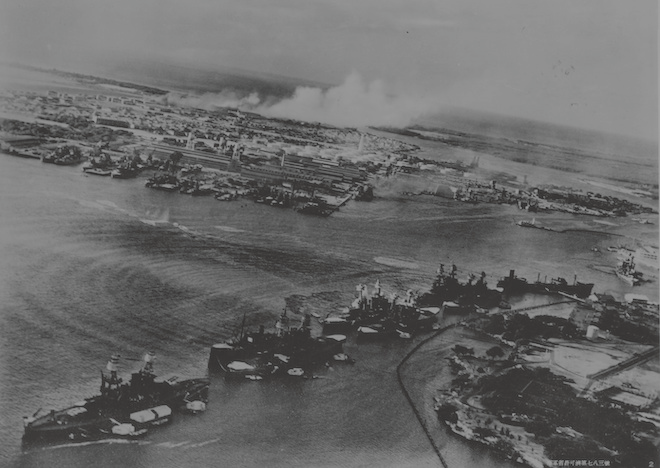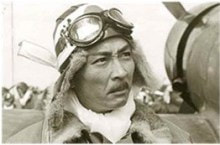I Led the Air Attack on Pearl Harbor By Captain Mitsuo Fuchida, former IJN
|
The following order was issued from Tokyo on the day that Akagi sailed into Tankan Bay:
Imperial General Headquarters Navy Order No.5 21 November 1941 To: Commander in Chief Combined Fleet Isoroku Yamamoto Via: Chief of Naval General Staff Osami Nagano By Imperial Order 1. Commander in Chief Combined Fleet will, at an appropriate time, dispatch to stand-by points necessary forces for execution of operations. 2. Commander in Chief Combined Fleet is empowered to use force in self defense in case his fleet is challenged by American, British or Dutch forces during the process of carrying out military preparations. 3. Detailed instructions will be given by the Chief of the Naval General Staff. _____________________________________________________________________ The designated stand-by point was 42°N 170°W over a thousand miles to the north of the Hawaiian Island chain.
At 0600 on the dark and cloudy morning of 26 November our 28-ship task force weighed anchor and sailed out into the waters of the North Pacific Ocean. The sortie was cloaked in complete secrecy. A patrol boat guarding the bay entrance flashed a message, "Good luck on your mission." But even that boat was unaware of our assignment. Akagi signalled, "Thanks," and passed by, her ensign fluttering in the morning breeze. It would not be long before this ensign was replaced by a combat flag. But this did not mean that the arrow had already gone from the bow. "In case negotiations with the U. S. reach a successful conclusion," Nagumo had been instructed, "the task force will put about immediately and return to the homeland." Unaware of this, however, the crews shouted "Banzai!" as they took what might be their last look at Japan. On Akagi's bridge Commander Gishiro Miura, the navigation officer, was concentrating all his energies on control of the ship. Whether we reached the scheduled launching point successfully rested entirely upon his shoulders. So tense was his appearance that it made us feel he was a completely different man. His usual jovial attitude had disappeared. He now wore shoes instead of his usual slippers, and he was neatly dressed, a decided change from his customary dirty, worn-out uniform. Captain Hasegawa, the skipper of the ship, stood beside him. Sitting at the flight desk control post under the bridge, I watched the gradually receding mountains of the Kuriles. Young boys of the flying crews were boiling over with fighting spirit. Hard nights and days of training had been followed by hasty preparations, and now the sortie, which meant that they were going to war. I felt their keen enthusiasm and was reassured. Still I could not help doubting whether Japan had the proper confidence for carrying out a war. At the same time, however, I fully realized my duty as a warrior to fight and win victory for my country. Personally I was opposed to the operational policy. The idea of an attack on Pearl harbor was a good one, but I thought the plan should have called for complete destruction of the United States Pacific Fleet at the outset, followed by an invasion of the Hawaiian Islands to push America entirely out of the Central Pacific. The plan covered expansion to the south—the Philippines, Malaya, Hongkong, Guam, and other such vulnerable positions. It was my opinion that if Pacific operations to the east proved successful, there would be no need for military operations in the south. Since the United States was the main foe, I could not understand why operations were not aimed directly toward the east. Admiral Yamamoto was quoted as having said that he had no confidence in the outcome of war after the first year. Why then, did he not press and press the enemy in the first year to force an early conclusion to the war? Anyway, the immediate mission was to strike a telling blow, and my assignment carried a grave responsibility. At the time I thought, "Who could be luckier than I?" My thoughts continued: What if the Fleet is not in Pearl Harbor? In such a case we would seek out the enemy en route to the attack. If we should meet the enemy tomorrow would Nagumo withdraw? No, we should attack and destroy him, I thought, and if the Admiral showed any hesitation, I would volunteer my views on these matters. Such thoughts came one after another, but one remained uppermost. I was determined to do my utmost for victory. In the meantime, the fleet had assumed formation. The carriers sailed in parallel columns of three followed by the tankers. On the outside two battleships and two heavy cruisers took positions, the whole group encircled by a screen of the light cruiser and destroyers. The submarines patrolled about 200 miles ahead of our force. The course was direct to the stand-by point, speed was fourteen knots. The first fueling at sea was carried out five days after our sortie, on 30 November. * * * more-> |

|
|

